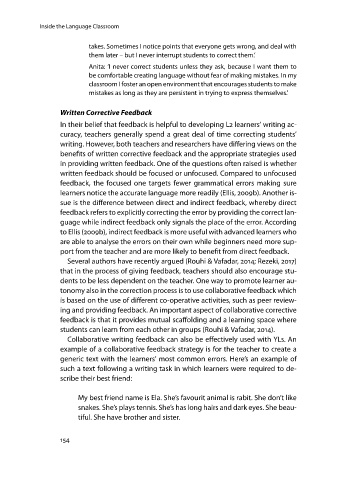Page 154 - Teaching English at Primary Level: From Theory into the Classroom
P. 154
Inside the Language Classroom
takes. Sometimes I notice points that everyone gets wrong, and deal with
them later – but I never interrupt students to correct them.’
Anita: ‘I never correct students unless they ask, because I want them to
be comfortable creating language without fear of making mistakes. In my
classroom I foster an open environment that encourages students to make
mistakes as long as they are persistent in trying to express themselves.’
Written Corrective Feedback
In their belief that feedback is helpful to developing L2 learners’ writing ac-
curacy, teachers generally spend a great deal of time correcting students’
writing. However, both teachers and researchers have differing views on the
benefits of written corrective feedback and the appropriate strategies used
in providing written feedback. One of the questions often raised is whether
written feedback should be focused or unfocused. Compared to unfocused
feedback, the focused one targets fewer grammatical errors making sure
learners notice the accurate language more readily (Ellis, 2009b). Another is-
sue is the difference between direct and indirect feedback, whereby direct
feedback refers to explicitly correcting the error by providing the correct lan-
guage while indirect feedback only signals the place of the error. According
to Ellis (2009b), indirect feedback is more useful with advanced learners who
are able to analyse the errors on their own while beginners need more sup-
port from the teacher and are more likely to benefit from direct feedback.
Several authors have recently argued (Rouhi & Vafadar, 2014; Rezeki, 2017)
that in the process of giving feedback, teachers should also encourage stu-
dents to be less dependent on the teacher. One way to promote learner au-
tonomy also in the correction process is to use collaborative feedback which
is based on the use of different co-operative activities, such as peer review-
ing and providing feedback. An important aspect of collaborative corrective
feedback is that it provides mutual scaffolding and a learning space where
students can learn from each other in groups (Rouhi & Vafadar, 2014).
Collaborative writing feedback can also be effectively used with YLs. An
example of a collaborative feedback strategy is for the teacher to create a
generic text with the learners’ most common errors. Here’s an example of
such a text following a writing task in which learners were required to de-
scribe their best friend:
My best friend name is Ela. She’s favourit animal is rabit. She don’t like
snakes. She’s plays tennis. She’s has long hairs and dark eyes. She beau-
tiful. Shehavebrother andsister.
154

